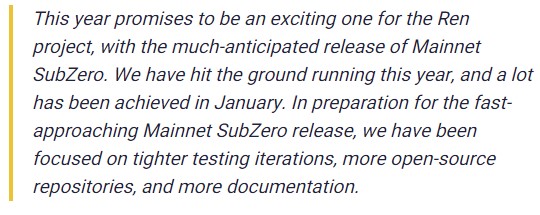Anytime soon, we will get to see Ren, the open protocol to launch its mainnet. Ren’s protocol offers ‘permission-less’ and ‘private’ transfers on the blockchain for all the dApps. The transfer can take place between any blockchain. Ren, last year released its testnet and a developer portal.
Ren’s mainnet is at the final-testing stage, after the successful Hyperdrive audit, and RZL sMPC audit. The platform wants to offer the deployment of RenVM with security and safety, to be called the ‘Mainnet SubZero,’ as per reports. On this, the CTO of Ren- Loong Wang shared-
The unique RenVM:
RenVM is the power engine of Ren. It is neither a product nor an application. It should rather be seen as a network (which accompanies SDK.) It offers ‘practical privacy’ and solutions operational on various platforms. It uses a ‘multi-party computation algorithm’ and, therefore, is the sole provider of private computation, which can be used on various inputs and on various parties. Not only this but the RenVM ‘network’ also supports developers to incorporate and offer ‘multi-chain functionality’ into their own applications too.
Reports reveal that RenVM is made of four key components:
- Shamir’s Secret Sharing: It is the bedrock that supports RenVM to maintain the secrecy of its data.
- Secure Multiparty Computation (sMPC): sMPC helps RenVM in running the secret scripts successfully.
- Byzantine Fault Tolerance: As per reports, it is an “uptime in a dynamic and potentially malicious environment.”
- Hyperdrive: It supports the decentralized consensus
Within this month, Ren has accomplished:
Ren’s RenJS:
Within this month, the platform has successfully completed and released RenJS. RenJS is like a basic library that supports third-party developers to understand to create the RenVM interacting app. For instance, this library helps developers in creating user-interfaces, bots, command-line tools, etc.
The GatewayJS by Ren:
In addition to RenJS, Ren has also completed ‘GatewayJS’ in this month. The platform is currently looking into the feedback from the community for the product before the final release. GatewayJS intends to offer completely integrated BTC experience to its users by supporting third-party developers to create secure user-interfaces. Reports suggest that it is integrated into ChaosDEX as an exposition.
The sMPC paper:
Thirdly, RZL sMPC paper is also all set for audit. The audit is planned to take place after the successful completion of Hyperdrive’s audit. The public verification by auditors will offer the developers the confidence to use it in the core execution engine within RenVM.
The new version of Lotan:
This month, the platform has also started the development of the chaos testing framework for RenVM. It is seen as a new version of Lotan. This version makes use of the RenJS library to run tests such as (crash tests, load tests, fuzz tests), and it also runs the compatibility tests against RenVM. It makes the final testing stage before the release of mainnet SubZero.
Smart contracts:
The platform has now also included the new Protocol smart contract. The users will be able to navigate easily and configure the on-chain contracts used by RenVM through these smart contracts. Not only the deployment of the various versions of RenVM will become more efficient, but it will also enhance the experience of the third-party developer.


